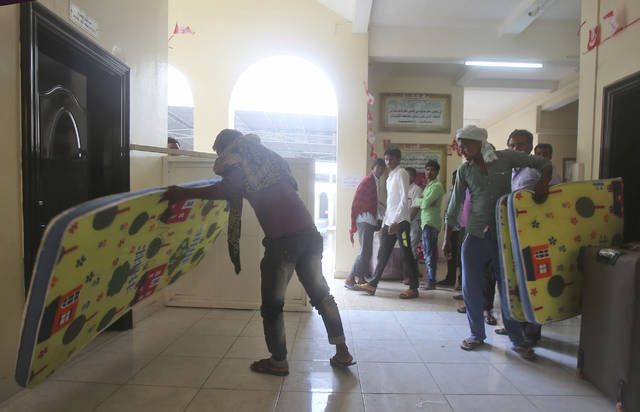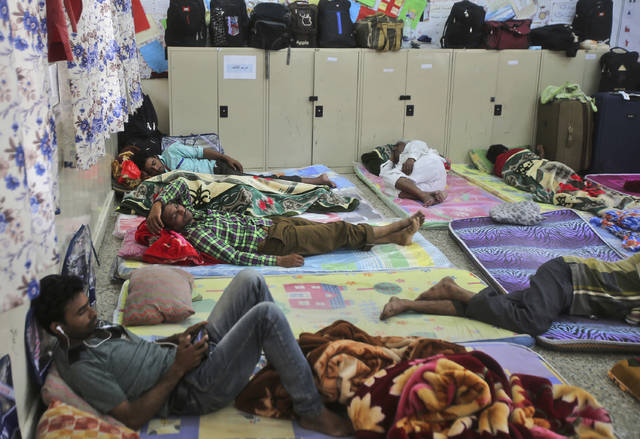Cyclone Mekunu nears Oman’s coast, kills 12-year-old girl

A man covers his head under the rain in Salalah, Oman, Friday, May 25, 2018. Cyclone Mekunu will be “extremely severe” when it crashes into the Arabian Peninsula this weekend, meteorologists warned Friday, after earlier thrashing the Yemeni island of Socotra. (AP Photo/Kamran Jebreili)

A car makes its way through standing water on a road in Salalah, Oman, Friday, May 25, 2018. Cyclone Mekunu will be “extremely severe” when it crashes into the Arabian Peninsula this weekend, meteorologists warned Friday, after earlier thrashing the Yemeni island of Socotra. (AP Photo/Kamran Jebreili)

A man covers his head under the rain in Salalah, Oman, Friday, May 25, 2018. Cyclone Mekunu pounded the Yemeni island of Socotra in the Arabian Sea on Thursday morning, lashing it with heavy rain and strong winds as the powerful storm remained on a path to strike Oman this weekend. At least 17 people were reported missing. (AP Photo/Kamran Jebreili)

Workers prepare to stay in a school turned into a shelter in Salalah, Oman, Friday, May 25, 2018. Cyclone Mekunu pounded the Yemeni island of Socotra in the Arabian Sea on Thursday morning, lashing it with heavy rain and strong winds as the powerful storm remained on a path to strike Oman this weekend. At least 17 people were reported missing. (AP Photo/Kamran Jebreili)

Workers take a rest in a school turned into a shelter in Salalah, Oman, Friday, May 25, 2018. Cyclone Mekunu pounded the Yemeni island of Socotra in the Arabian Sea on Thursday morning, lashing it with heavy rain and strong winds as the powerful storm remained on a path to strike Oman this weekend. At least 17 people were reported missing. (AP Photo/Kamran Jebreili)

A man walks down the stormy beach at a hotel in Salalah, Oman, Friday, May 25, 2018. Cyclone Mekunu will be “extremely severe” when it crashes into the Arabian Peninsula this weekend, meteorologists warned Friday, after earlier thrashing the Yemeni island of Socotra. (AP Photo/Kamran Jebreili)
SALALAH, Oman — Cyclone Mekunu neared the Arabian Peninsula on Friday as its outer bands dumped heavy rain and bent palm trees in Oman, a sign of the approaching storm’s power after earlier thrashing the Yemeni island of Socotra.
SALALAH, Oman — Cyclone Mekunu neared the Arabian Peninsula on Friday as its outer bands dumped heavy rain and bent palm trees in Oman, a sign of the approaching storm’s power after earlier thrashing the Yemeni island of Socotra.
Already at least 40 people, including Yemenis, Indians and Sudanese, were reported missing on Socotra, where flash floods washed away thousands of animals and cut power lines on the isle in the Arabian Sea. Officials feared some may be dead while authorities in Oman confirmed the first death in the cyclone.
The cyclone is expected to make landfall early Saturday near Salalah, Oman’s third-largest city and home to some 200,000 people close to the sultanate’s border with war-ravaged Yemen.
Conditions quickly deteriorated in Salalah after sunrise Friday, with winds and rain beginning to pick up. Strong waves smashed into empty tourist beaches. Many holidaymakers fled the storm Thursday night before Salalah International Airport closed. The Port of Salalah — a key gateway for the country — also closed, its cranes secured against the pounding rain.
Streets quickly emptied across the city. Standing water covered roads and caused at least one car to hydroplane and flip over.
Later, a municipal worker on a massive loader used its bucket to tear into a road median to drain a flooded street, showing how desperate the situation could become.
Omani forecasters warned Salalah and the surrounding area would get at least 200 millimeters (7.87 inches) of rain, over twice the amount of rain this city typically gets in a year. Authorities remained worried about flash flooding in the area’s valleys and potential mudslides down its nearby cloud-shrouded mountains.
A sizable police presence fanned out across Salalah, the hometown of Oman’s longtime ruler Sultan Qaboos bin Said. Many officers rode in Royal Oman Police SUVs with chicken wire over the windows, likely because their other vehicles weren’t tall enough to maneuver through the flood water.
“Of course, for the citizen there is going to be a sense of fear of the consequences that can happen,” said Brig. Gen. Mohsin bin Ahmed al-Abri, the commander of Dhofar governorate’s police. “We have been through a few similar cases and there were losses in properties and also in human life as well. But one has to take precautions and work on that basis.”
The Royal Oman Police later said on Twitter that a 12-year-old girl died after winds from the cyclone caused her to collide with a wall.
As torrential rains poured down, local authorities opened schools to shelter those whose homes are at risk. About 600 people, mostly laborers, huddled at the West Salalah School, some sleeping on mattresses on the floors of classrooms, where math and English lesson posters hung on the walls.
Shahid Kazmi, a worker from Pakistan’s Kashmir region, told The Associated Press that police moved him and others to the school. He acknowledged being a bit scared of the storm but said: “Inshallah, we are safe here.”
India’s Meteorological Department said the storm packed maximum sustained winds of 170-180 kph (105 to 111 mph), gusting up to 200 kph (124 mph). They described the cyclone as “extremely severe.”
“Salalah is expected to experience maximum wind and maximum rainfall and also the maximum storm surge,” said Mrutyunjay Mohapatra of the department.
On Socotra, authorities relocated over 230 families to sturdier buildings and other areas, including those more inland and in the island’s mountains, Yemeni security officials said, speaking on condition of anonymity because they were not authorized to talk to reporters.
Flash floods engulfed Socotra streets, cutting electricity and communication lines, they said. At least 40 people were missing, they added. Some humanitarian aid from Saudi Arabia and the United Arab Emirates arrived on the island just hours after the cyclone receded.
The officials said heavy rains pummeled Yemen’s easternmost province of al-Mahra, along the nation’s border with Oman.
Socotra Gov. Ramzy Mahrous said one ship sank and two others ran aground in the storm, initially saying authorities believed 17 people were missing.
“We consider them dead,” the governor said.
Yemen’s self-exiled President Abed Rabbo Mansour Hadi issued a statement ordering troops under his command on the island to help citizens, deliver supplies and reopen roads.
The island, listed by UNESCO as a World Heritage Site, has been the focus of a dispute between the UAE and Yemen’s internationally recognized government amid that country’s war after Shiite rebels, known as Houthis, seized the Yemeni capital, Sanaa.
Socotra has a unique ecosystem and is home to rare plants, snails and reptiles that can be found nowhere else on the planet. It is known for its flower-and-fruit bearing dragon blood tree, which resembles an umbrella and gets its name from the dark red sap it secretes.
A cyclone is the same as a hurricane or a typhoon; their names only change because of their location. Hurricanes are spawned east of the international date line. Typhoons develop west of the line and are known as cyclones in the Indian Ocean and Australia.
Powerful cyclones are rare in Oman. Over a roughly 100-year period ending in 1996, only 17 recorded cyclones struck the sultanate on the eastern edge of the Arabian Peninsula. In 2007, Cyclone Gonu tore through Oman and later even reached Iran, causing $4 billion in damage in Oman alone and killing over 70 people across the Mideast.
The last hurricane-strength storm to strike within 160 kilometers (100 miles) of Salalah came in May 1959, according to the U.S. National Oceanic and Atmospheric Administration’s archives. However, that cyclone was categorized as a Category 1 hurricane, meaning it only had winds of up to 152 kph (95 mph).
Mekunu, which means “mullet” in Dhivehi, the language spoken in the Maldives, is on track to potentially be the same strength as a Category 2 hurricane at landfall. It also comes just days after Cyclone Sagar struck Somalia.
———
Associated Press writers Fay Abuelgasim in Salalah, Oman; Ahmed al-Haj in Sanaa, Yemen; and Menna Zaki in Cairo contributed to this report.
———
Follow Jon Gambrell on Twitter at https://twitter.com/jongambrellAP . His work can be found at http://apne.ws/2galNpz .

